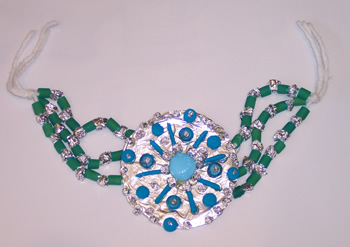Sacred Images - Navajo Silver Work
Summary
Students will design and produce a representation of Navajo silver jewelry, realizing its cultural importance in Navajo families and communities.
Materials
Attachments
- Sacred Images: A Vision of Native American Rock Art, Leslie Kelen and David Sucec (ISBN 0-87905-734-3)
- 2-inch tag board circle for each student
- Three 18 inch long pieces of yarn for each student (it might be helpful to have the ends of the yarn coated in Elmer's glue and dried, so that the yard doesn't fray when they thread the noodles on.)
- Additional string or yarn to elongate for belt or necklace
- Turquoise-colored short macaroni noodles
- Toothpicks
- Glue
- Duct tape
- Turquoise-colored buttons
- Turquoise-colored Play-doh
- Silver glitter glue for embellishment and to cover button holes
- Aluminum foil
- Student "Navajo Silver Work" Project Example

Background for Teachers
- Meaning of adornment
- Refer to Native Americans: Primary, The Education Center, The Best of The Mailbox Theme Series (ISBN 1-56234-500-1)
The Navajo make one of the best-known Native American crafts today: stunning turquoise and silver jewelry. They began making such jewelry in the 1800s.
If possible, bring in or wear some actual pieces of such jewelry to share with the children. This "jewelry holds special meaning to the Navajo people because in their culture turquoise represents harmony and beauty."
Examine plate 35, page 70 and plate 38, page 75 from Sacred Images.
Students should be able to connect various kinds of art with particular cultures, times, and places and its link to Utah history, culture and art. Respect for nature and creating something beautiful are important parts of the learning process.
Intended Learning Outcomes
1. Demonstrate responsible, emotion al and cognitive behaviors.
2.
Communicate clearly in oral artistic, written, and nonverbal form.
Instructional Procedures
- Show and discuss pictures or actual Navajo silver-and-turquoise jewelry. Explain that this "jewelry holds special meaning to the Navajo people because in their culture turquoise represents harmony and beauty."
- Show and examine plate 35, page 70 and plate 38, page 75 from Sacred Images to the children. Look at the circles, what do you think they represent?
- Have students begin their own jewelry pieces by covering the tagboard circle with aluminum foil. Use the glue to attach turquoise buttons and pieces of turquoise-colored Play-doh to the foil.
- When glue has dried, use a toothpick to carefully etch details into the foil.
- Securely tape the center of the three pieces of yarn to the back of the circle.
- Crumple small pieces of foil around the yarn to create silver beads and alternate them with the turquoise-colored noodles. Have children create a pattern.
- Tie the string ends off to create a bracelet or armband. Add more string to both ends to make them a necklace or belt.
- Have the students talk about this experience and how proud they feel about creating something they are happy to wear.
- Remind them of the importance of the circle. Refer to Gallery Walk of Sacred Images Attachment #5: The Rock and The Eagle Speaks, Hank LaRose, Bear Boy
Updated: 02/03/2018


 UTAH EDUCATION NETWORK
UTAH EDUCATION NETWORK

 Justin
Justin Braxton
Braxton Dani
Dani Kayla
Kayla Katie
Katie Matthew
Matthew Rob
Rob Val
Val
